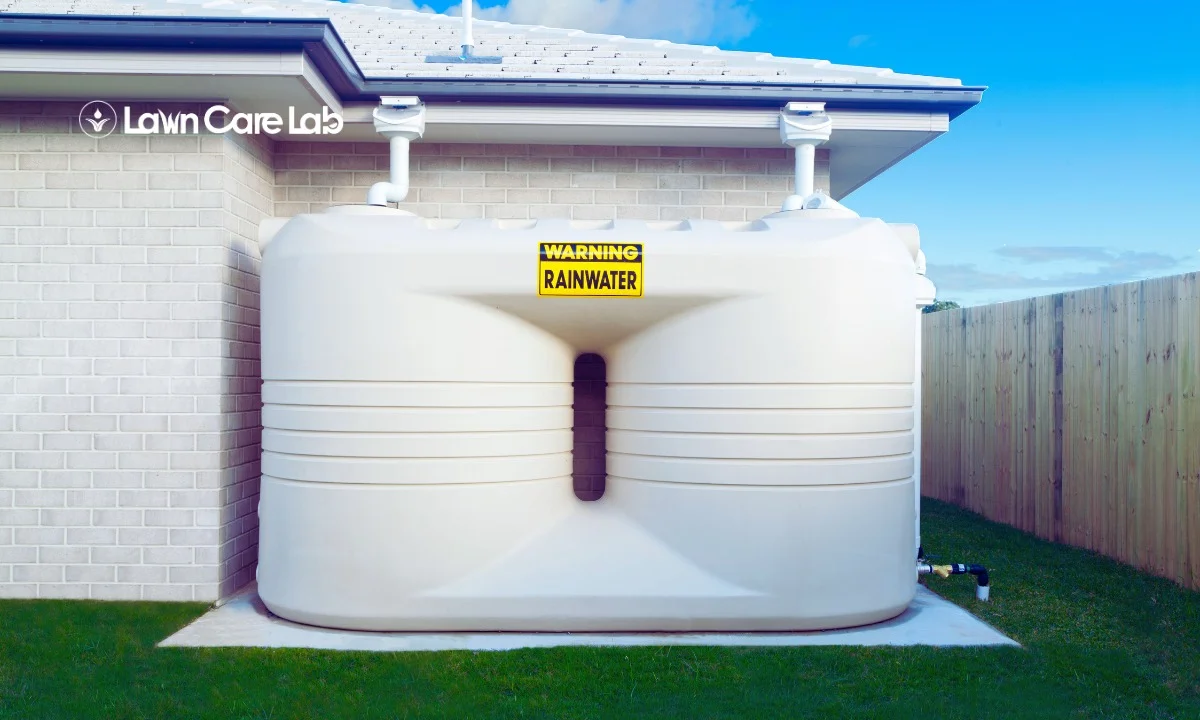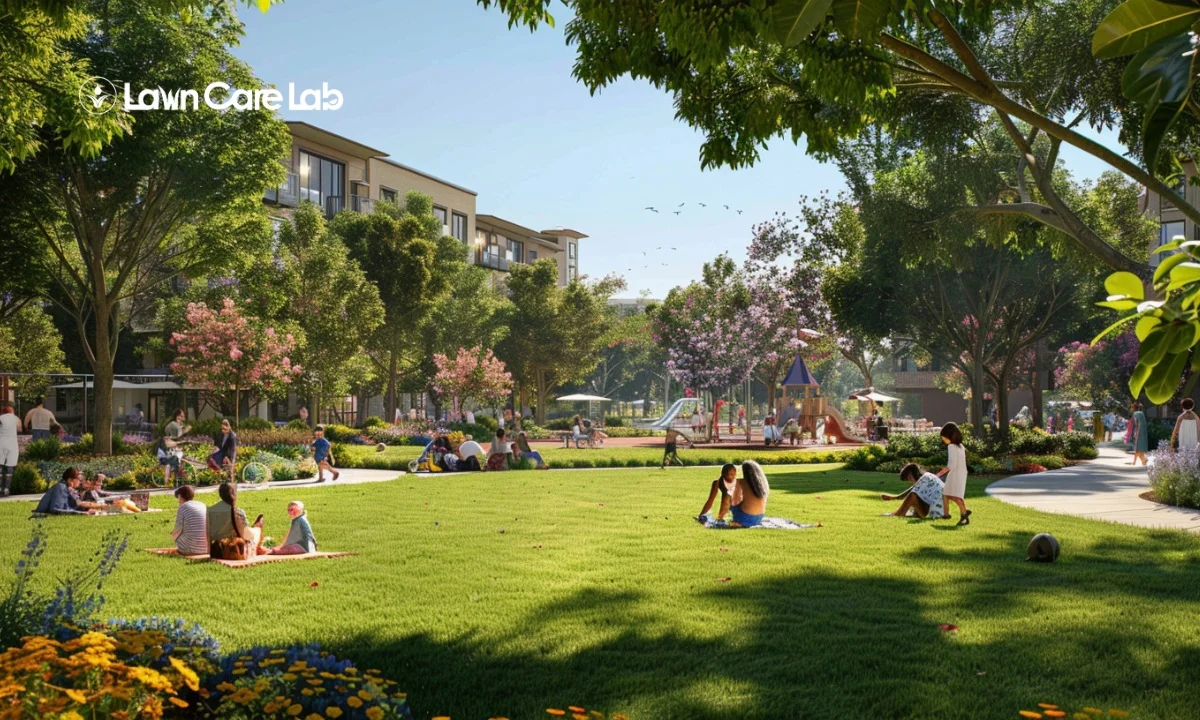Transform your lawn care routine by harvesting rainwater. This eco-friendly practice can save you money while maintaining a healthier lawn.
Rainwater is free of chemicals found in tap water and can reduce your dependence on municipal water, leading to significant savings on your bills.
Get started with a rain barrel, a downspout diverter, and some simple plumbing skills. You make a big difference to your lawn, pocket, and the planet by implementing rainwater harvesting.
Table of Contents
Understanding the Basics of Rainwater Harvesting
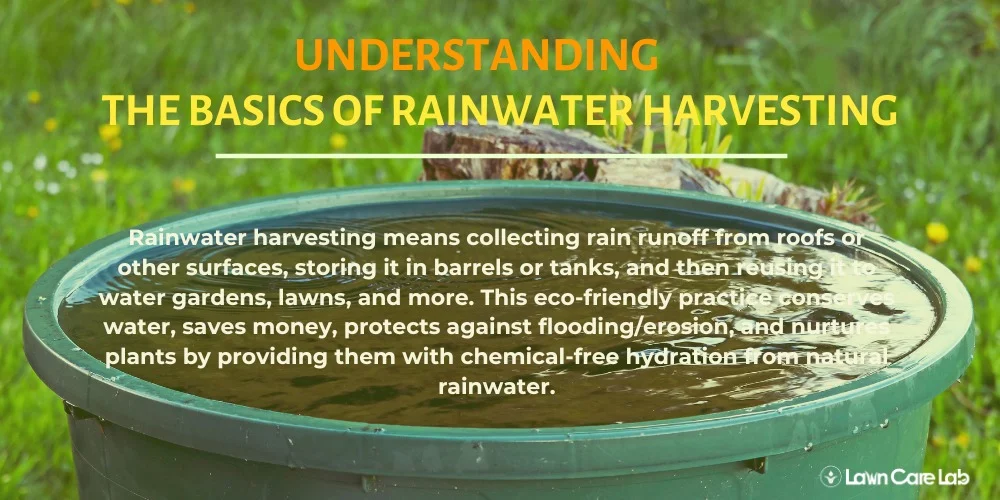
If you’re asking yourself, what’s rainwater harvesting? Well, it’s a simple concept.
It involves gathering rainwater, saving it, and then reusing it instead of letting it go to waste through runoff.
This method could significantly impact your gardening practices, providing an environmentally friendly and cost-saving measure.
More than that, it’s a step towards addressing the global issue of water shortage.
What is Rainwater Harvesting?
Rainwater harvesting is an eco-friendly way of maintaining your lawn. It involves collecting and storing rainwater from your house’s roof.
Let’s break down this sustainable practice into three fundamental steps:
- Gathering: This is where rainwater is collected from hard surfaces, typically your rooftop, when it’s raining.
- Preserving: The collected rainwater is then stored in a container or barrel to be used at a later date.
- Utilizing: Rainwater can be used for gardening, irrigation, and drinking after treatment.
Rainwater harvesting conserves water and promotes a healthy environment. It’s a practical way to make a positive impact on the earth.
Importance of Rainwater Harvesting in Lawn Care
Rainwater harvesting is an eco-friendly and cost-effective way to maintain your lawn. It reduces your need for city water and also lowers the risk of flooding and soil erosion.
Rainwater is chemical-free and promotes soil health and plant growth. Implementing rainwater harvesting can significantly reduce water costs and benefit your lawn maintenance.
Understanding the significance of rainwater harvesting for lawn care, let’s see how you can incorporate this beneficial practice into your routine.
Steps to Implement Rainwater Harvesting in Your Lawn Care Routine
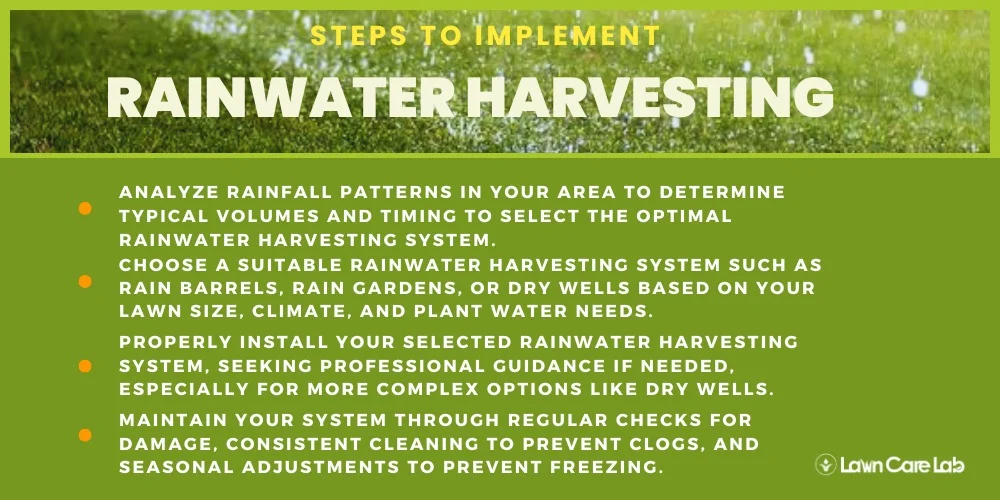
Know your rain patterns to choose a suitable system for rainwater harvesting in your lawn care.
After selecting the appropriate system, the next steps involve proper installation and maintenance to ensure optimal results.
“Rainwater is a gift to the garden”, says a wise gardener. Harvesting rainwater saves water and helps the environment. Ongoing maintenance is crucial for sustained effectiveness.
Analyzing Rainfall Patterns in Your Area
Before we begin discussing how to set up a rainwater harvesting system, it’s worthwhile to gain an understanding of your local rainfall patterns.
Here’s a simple guide on how to achieve this:
- Investigate Past Rainfall Records: Start by reviewing historical rainfall data for your region to understand typical monthly precipitation.
- Utilize Internet Tools: There are numerous online tools available, such as the National Weather Service, that provide detailed rainfall data, including seasonal variations.
- Monitor and Record: Keep track of the rainfall in your area over a certain timeframe. This will help you become aware of current patterns.
Selecting Suitable Rainwater Harvesting System
Harvesting rainwater is a sustainable way to maintain your garden. Find the best method based on your property’s size, local climate, and plant water needs.
You can consider options like rain barrels, creating a rain garden, or installing dry wells, as these are prevalent and have shown to be effective.
Rain Barrels
Deciding on the perfect rain barrel is a significant step in setting up an efficient rainwater harvesting system for your lawn care needs.
Here are some aspects you need to think about:
- Size: A larger barrel can store more water.
- Material: Choose materials that are long-lasting and free from toxins.
- Location: Setting it up near a downspout allows for easy water collection.
Making a safe and efficient choice is critical.
Rain Gardens
Consider setting up a rain garden alongside your rainwater collection system. It can improve your lawn’s health and safety by absorbing water runoff from your property. Plus, it serves as a protective measure against potential water damage.
Dry Wells
Having established your rain garden, it’s time to step up your rainwater collection game by incorporating a dry well into your regular lawn maintenance.
Choosing the Perfect Spot: The first step in building a dry well is to select a location away from buildings to prevent structural damage.
Preparing the Ground: First, you need to determine the size of the dry well you’re installing to determine the dimensions of the hole needed.
Installing the Dry Well: Place the dry well inside the hole. Fill the surrounding area with gravel, then cover it with soil.
Adding a dry well to your garden helps manage excess rainwater and maintain plant health. It’s smart, eco-friendly, and prevents problems.
Installing the Rainwater Harvesting System
Install a rain barrel under a downspout for an easy rainwater harvesting system.
Seek professional help for more complex systems like dry wells to ensure safety and optimal performance. Once installed properly, enjoy the benefits!
Following this, we’ll provide you with some handy maintenance advice for your system.
Maintenance Tips for Your Rainwater Harvesting System
Maintenance of your rainwater harvesting system is vital for its efficient performance and longevity, particularly when it comes to supporting your garden. Here are three steps to keep your setup in excellent shape:
- Routine Checks: Examine all components of your system regularly to detect early signs of wear, damage, or leakage, which can prevent costly repairs in the future.
- Consistent Cleaning: Make sure to regularly clear gutters and filters to prevent blockages and ensure clean water collection.
- Seasonal Adjustments: During colder months, adjust your system to prevent freezing and damage.
Maintenance is crucial for promoting garden well-being and home safety. Rainwater harvesting is an impactful method for sustainable garden care, as it fosters a more interconnected and eco-friendly ecosystem.
The Role of Rainwater Harvesting in Sustainable Lawn Care
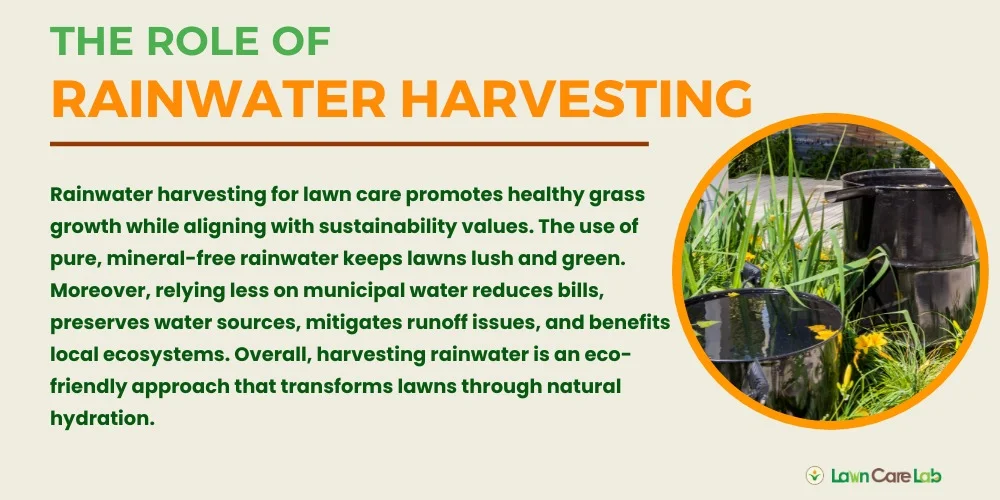
Harvesting rainwater for lawn care is a cost-effective and eco-friendly way to promote healthy grass. It reduces water bills, mitigates water scarcity issues, and lowers our carbon footprint by reducing reliance on municipal water supplies.
Advantages of Using Harvested Rainwater
Using harvested rainwater can transform your garden by providing natural hydration to your plants while reducing your water bills and contributing to water conservation.
Let’s highlight the three primary advantages of using harvested rainwater:
- Plant Welfare: Rainwater is free of harmful chemicals like chlorine, making it a pure and natural source of hydration for plants, promoting their overall health and growth.
- Money-saving: Reducing your dependency on municipal water and using free rainwater can help you save on water bills.
- Eco-friendly Choice: Using rainwater helps conserve resources and aligns with sustainability values.
In essence, harvested rainwater can be a triple threat. It’s beneficial for your garden, your wallet, and our planet.
Impact on Lawn Health and Appearance
Collecting rainwater is an eco-friendly way to care for your lawn. It is softer and devoid of minerals, making it more effective at hydrating your plants.
This leads to a healthier, more attractive lawn that withstands tough conditions.
Plus, it helps reduce your water bills. Use natural resources like rainwater to create a beautiful environment in your backyard.
Environmental Benefits of Rainwater Harvesting
Harvesting rainwater for your lawn is a sustainable practice that benefits both your yard and the environment.
Consider these three primary gains:
- Preservation of Water: Harvesting rainwater reduces reliance on rivers and underground sources, preserving them for future generations.
- Mitigation of Soil Erosion and Flooding: Collecting rainwater helps reduce excess run-off, leading to soil erosion and flooding. This benefits local ecosystems’ health.
- Promotion of Biodiversity: Harvesting rainwater supports sustainable habitats, benefiting plant and animal species.
Overcoming Challenges in Implementing Rainwater Harvesting
Implementing a rainwater harvesting system may pose certain challenges, like laws and regulations, the cost of the initial setup, and potential health risks.
However, there’s no need for concern. Studies indicate that a well-planned strategy can effectively overcome these obstacles.
We’ll discuss practical ways to tackle these challenges, assisting you in realizing your rainwater harvesting project.
Dealing with Legal Restrictions
Before setting up your rainwater harvesting system, it’s important to check for any local legal restrictions that might be in place to prevent issues like water hoarding or misuse, which can negatively impact the community.
Here’s a straightforward plan to ensure you’re on the right side of the law:
- Start by contacting the local water management authorities to learn about relevant laws.
- To ensure full compliance with environmental law, consider consulting a specialist.
- Once you understand the regulations, apply for any necessary permits and arrange for any inspections that might be needed.
By adhering to these steps, you can set up your rainwater harvesting system without breaking any rules, effectively turning a potential problem into a solution.
Addressing Initial Setup Costs
Initial costs for setting up a rainwater harvesting system may seem high. Still, it’s an investment in a self-reliant water source that reduces reliance on city water, lowers water bills, and helps the environment. Check for rebates or incentives and consider DIY options to save money. Rainwater harvesting promotes a sustainable future.
Mitigating Potential Health Risks
While reusing rainwater offers significant benefits, it’s vital to remember that improper care of your harvesting system might introduce health issues.
Here’s a simple three-step routine to make sure your system remains safe:
- Consistent Cleaning: Regular cleaning can prevent bacteria contamination and maintain hygiene.
- Appropriate Purification: Apply suitable methods to eliminate pathogens in the harvested rainwater.
- Frequent Testing: Ensure the safety of your harvested rainwater by regularly testing it before using it, especially for lawn maintenance.
By following these steps, you’re safeguarding your health and guaranteeing that your lawn gets the highest quality care. Being proactive and meticulous in managing your system is the key.
Embrace Rainwater Harvesting for a Thriving Lawn
Collecting rainwater to maintain your lawn is cost-effective, sustainable, and chemical-free. This eco-friendly practice can help you save on utility bills and promote water conservation.
It also contributes to a more vibrant and lush lawn. Join the trend towards environmental sustainability and implement rainwater harvesting today.
Help your lawn thrive while doing your part for a better future.
- How to Create a Lawn Care Schedule for Southern Climates - October 30, 2024
- How to Use Compost Tea to Boost Lawn Growth and Soil Health - October 23, 2024
- The Best Grasses for Saltwater-Exposed Lawns: Coastal Lawn Care - October 17, 2024

